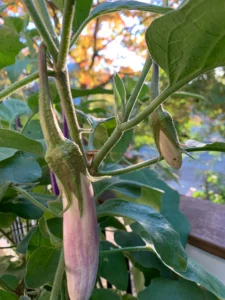Plants not behaving as expected: vegetable garden edition
Thanks to the University of Maryland/Maryland Grows this informative article on plants not behaving as expected.
Vegetable crops
Two of the vegetable crops I grew this year are known for loving the heat: okra and eggplant. I grow eggplant in pots on my deck, to avoid flea beetle infestation, and okra directly in the ground in my community garden plot. Both of them produced adequately over the summer. Now it’s fall; we’re having days in the 70s and nights in the 50s, and there are fewer hours of sunlight in the day. Time to pull the summer crops, right?
Except – boom! Both the okra and the eggplant are going gangbusters. More flowers, more fruits than in the hot summer months, by far.

So why aren’t these plants following the rulebook? Do they not know how to read? Or have the rules changed?
For the last month or two, I’ve been getting near-daily text messages from MG Pat Lynch, documenting her struggle to harvest even a single zucchini from her plants. But no luck – all of the flowers on Pat’s zucchinis were male. To get squash fruit, you need both male and female flowers.
If you don’t know how to tell the difference between male and female flowers, or how to pollinate flowers yourself if the bees don’t arrive, watch this video with Joyce Browning, MG Coordinator for Harford County:
Pollination
Squash plants often produce only male flowers early on in the season. The males invite the bees; it’s pollination practice, so that when the female flowers show up, everything goes smoothly. If pollination doesn’t happen properly, the fruit will either fail completely or be misshapen. Female flowers, with their ovaries that turn into fruit, are a big investment for the plants. Producing fruit takes energy, and the plant will need lots of nutrients and water; it needs to be healthy and strong to get that fruit to maturity. But usually, the plant reaches a point where it’s ready, and fruit happens.
So why did Pat’s plants never get there? Usually, the answer is stress; the plants just never “felt” ready to make fruit, because they didn’t “think” they could survive long enough. The most common stressors are drought and heat. Pat is sure she watered enough, and we’ve also had a fair amount of rain, so soil moisture isn’t in question. It was pretty hot for a while there, though. But after things cooled down, the plants still didn’t make female flowers.
Another possible explanation has to do with soil nutrients. If the soil is lacking in the nutrients the plant needs, it might not produce female flowers, but it would also look scrawny and about to die, and these were healthy-looking plants. I’ve also often seen squash plants that never managed to grow large but still put out some flowers and fruit, trying desperately to reproduce before it was too late (and usually failing). I think the more likely explanation is that the soil nutrients weren’t balanced. Too much nitrogen in comparison to phosphorus and potassium could result in big green plants with lots of leaves that never made any flowers at all, or – in this case – produced only male flowers, because the nutrients that support growth of fruits were insufficient.
Soil test
Now, it is possible that when Pat gets a soil test to measure what’s in her beds, she’ll find that the phosphorus and potassium levels are just fine, in which case I’m going to put this in the It’s A Big Mystery category. Occasionally, stuff just happens. Maybe squirrels were sneaking in early in the morning and eating all the female flowers? Maybe the plants were somehow putting up No Girls Allowed signs?
I think my okra and eggplant late-season success is easier to explain. It’s been hot, and it’s hard to keep up with watering enough to supply plants that are heat-stressed. Yes, both of these species evolved in hot places, but that doesn’t mean they aren’t relieved by a breath of cooler air. And that cooler air signals that winter is on its way, which means the plants will die; they’d really like to make some seeds before then, although I’m going to frustrate them by picking all the fruits well in advance of full maturity.
I’ve also got some nice peppers still coming along, though others gave up and have been pulled, and the few tomato plants I have left are coming out this week. It was a bad year for fungal diseases (or… a good year for the diseases; a bad year for gardeners who didn’t want their plants to get sick) and I didn’t have any difficulty deciding to take the tomatoes out and replace them with broccoli and collards. Some years, that’s a hard choice. As our climate continues to alter, we’re going to be facing a lot of hard choices, of which “do I keep harvesting tomatoes into November?” is a minor one. But it still makes garden planning difficult.
Plan for next year
If you’re having trouble squeezing in those fall vegetables among summer plants that are unexpectedly still chugging along, consider finding space for another raised bed or some containers somewhere. Next year, you can try to plan ahead; instead of planting another summer crop in an empty space (like, when your zucchini dies after a squash vine borer invasion), throw in a cover crop of buckwheat or alfalfa, and reserve the spot for cool-weather plants. Although I’m hearing the eggplant and okra challenge that “cool-weather” definition. Broccoli, get out of our way; it’s gumbo in October this year.
By Erica Smith, Montgomery County Master Gardener
Oh by the way, I’m never too busy for any of your referrals! If you are looking to buy or sell your home (with or without a garden), contact Gigi today.





Recent Comments